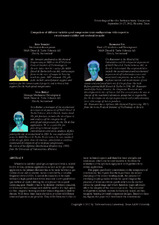| dc.contributor.other | Turbomachinery Symposium (41st : 2012) | |
| dc.creator | Somaini, Reto | |
| dc.creator | Urs, Baumann | |
| dc.creator | Bidaut, Yves | |
| dc.date.accessioned | 2017-10-04T19:47:56Z | |
| dc.date.available | 2017-10-04T19:47:56Z | |
| dc.date.issued | 2012 | |
| dc.identifier.uri | https://hdl.handle.net/1969.1/162965 | |
| dc.description | Tutorial | en |
| dc.description.abstract | Wherever a variable speed gas compression train is needed for Oil & Gas upstream applications as well as for gas storage applications the primary decision has to be made between a gas turbine driver and an electric motor controlled by a variable frequency drive (VFD). A second decision has to be made between a high speed direct driven train and a low speed driver (gas turbine or motor) driving the compressor via a speed increasing gear. Finally it has to be decided whether a classical, oil lubricated train arrangement shall be used or if a high speed, oil-free, magnetic bearing levitated train configuration shall be chosen. With these three major decisions a variety of different train configurations are possible. They differ from each other in many technical aspects and therefore have strengths and weaknesses which can be rated in order to facilitate the evaluation of the optimum equipment configuration for a certain application. This paper specifically concentrates on the comparison of rotordynamic key figures like the logarithmic decrement (damping) of the lowest bending mode, the presence of overhung coupling modes within the speed range or the presence of torsional critical speeds which can be excited within the speed range and which therefore might adversely affect the integrity of the train components. The evaluated configurations include modern hermetically sealed, oil-free, magnetic bearing levitated compressor designs. Based on these key figures this paper will benchmark the rotordynamic robustness as well as the operational safety of the investigated train configurations. | en |
| dc.format.medium | Electronic | en |
| dc.format.mimetype | application/pdf | |
| dc.language.iso | en | |
| dc.publisher | Texas A&M University. Turbomachinery Laboratories | |
| dc.relation.ispartof | Proceedings of the 41st Turbomachinery Symposium | en |
| dc.subject.lcsh | Turbomachines | en |
| dc.title | Comparison Of Different Variable Speed Compression Train Configurations With Respect To Rotordynamic Stability And Torsional Integrity | en |
| dc.type.genre | Presentation | en |
| dc.type.material | Text | en |
| dc.identifier.doi | https://doi.org/10.21423/R1MS8T | |


